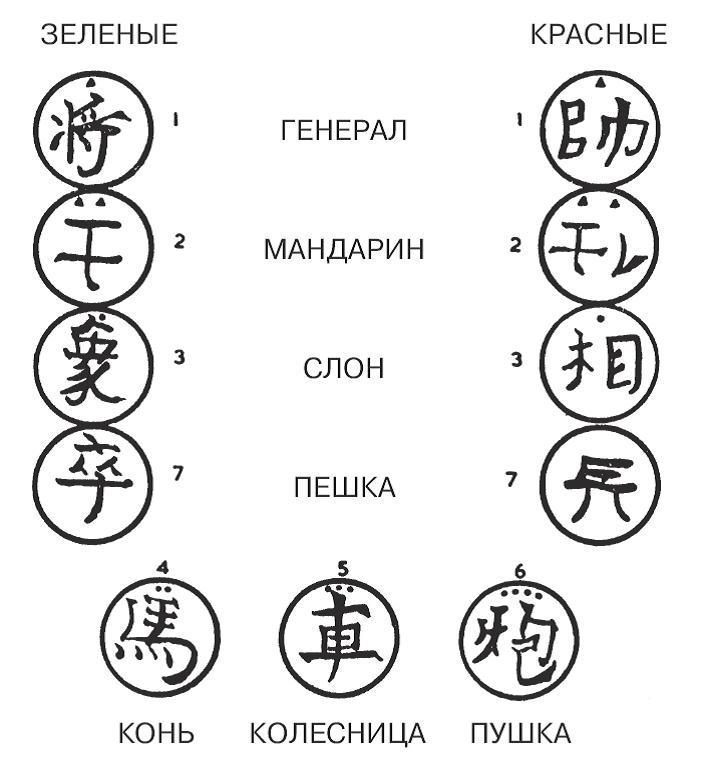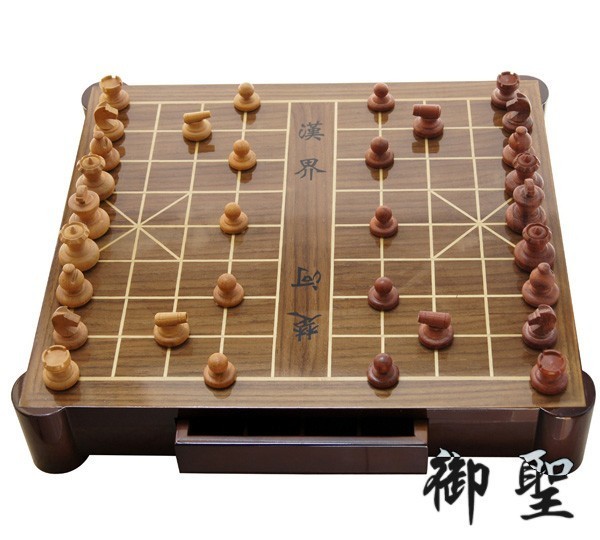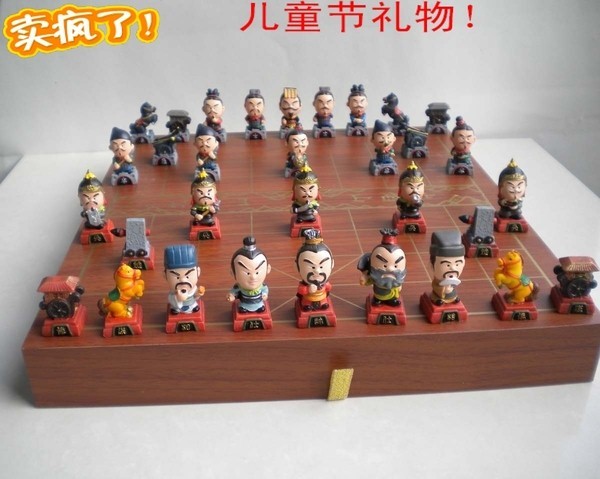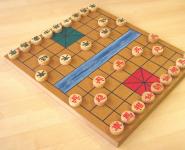Xiangqi: Chinese Chess Type Game
If you visit China and decide to look at the life of ordinary Chinese, then you will definitely come across this picture.
Men enthusiastically play a board game that looks like ... checkers. Yes, yes it is CHECKS, but you are mistaken, this game is of the chess type. Before us is a classic confrontation between two armies of figures of different ranks.
Many European researchers call this game CHINESE CHESS, which, in my opinion, is not entirely true. This is XIANTQI, a Chinese chess game with a long history and unique originality.
Western researchers usually consider xiangqi as one of the branches of the development of the class of games, the root of which is shaturanga (chaturanga). According to this version, it is believed that shaturanga (chaturanga) is the common ancestor of all currently known chess-type games. Moving westward, shaturanga (chaturanga) gave birth to the Arab shatranj, which became the ancestor of modern classical chess. Spreading to the east and reaching China, shaturanga (chaturanga), and possibly even shatranj, changed in accordance with Chinese traditions and turned into xiangqi.
This is how Robert Bell describes the origin and design of the game in his book: “Shatranj in a new form has undergone significant changes, and already elephants, horsemen, infantrymen, a cannon with war chariots fought to capture the enemy general. Each army had a fortress, in which the general and his tangerines hatched their plans. To win the party, it was necessary to storm the enemy's fortress. A river flowed between the two armies, which the heavily laden elephants could not cross. Other minor pieces forced it freely. "
Chinese researchers strongly disagree with the theory of the origin of XIANTQI from shaturanga (chaturanga). Based on documents, the oldest of which date from the Han era, they claim that the game that became the ancestor of XIANTQI originated in ancient China about 3,500 years ago and was originally called LYUBO. In this game, chips were also moved around the board, among which were pawns and a general, which had different rules for the move, but dice were used to determine the move, thus introducing an element of randomness into the game. Just like the progenitor of shaturanga (chaturanga) was the game TAAYAM. Later, the bones were abandoned, having received the game GEUILI SAIZHAN.
In the Tang era, the rules of the game were modified, and the variety of figures was increased, which led to the emergence of the rules of XIANTSI, close to modern ones. It is quite definitely proven that in the 8th century in China XANTSI existed, two players played in them, the dice were no longer used, and the set of figures corresponded to the set of shaturanga (chaturanga) figures - a general (king), a horse, an elephant, a chariot (rook) and soldiers (pawns).
So let's take a look at the game itself.
The board for the game in SYANTSI consists of two halves with 8 by 4 squares, which are separated by a space of one square width, known as the RIVER (or POND). Each half of the board has four squares marked with diagonals, thus forming a square of nine points represents a FORTRESS (CASTLE). When playing, the pieces are placed at the intersections of the lines, not in the squares themselves. Therefore, the board is viewed as one large space of 9 by 10 dots.

In the classic game, the pieces are circular discs of the same size. On the upper side of the figure, its meaning is written. Typically, inscriptions are made in red and green (sometimes black). When writing equivalent figures, various Chinese characters are used to denote them, for example, if the inscriptions on some figures were in English, and on others - in German.
The following pieces are presented on the board in SYANTSI (taking into account the rules of their movement during the move):
GENERAL for the "greens" ("blacks") / MARSHAL for the red - a piece similar to the chess KING, his loss means the player's loss in the game. It can move one point in the vertical or horizontal direction, but in its movements it is limited to nine points of its fortress (castle). Generals cannot look face to face at each other (when there are no pieces on the vertical line between them), in this case, in response to the move that liberated the line, the general can attack across the entire field and kill the enemy general with his “gaze” (a very funny rule with an oriental flavor, shots from Chinese historical films with the piercing glances of actors playing the role of some generals immediately come to mind).
GOVERNOR for the "green" ("black") / MANDARIN for the red - the piece can move one point along the diagonal, but they are also limited in their actions by the boundaries of the fortress, ie. five points marked with bold lines.
ELEPHANT for "green" ("black") / MINISTER for red - a piece can move diagonally only to one next point, besides this, a piece cannot cross a river (pond) and invade enemy territory.
RIDER / HORSE - a piece can move one point vertically or horizontally and then move one point diagonally. Unlike a chess knight, a knight in xiangqi is an ordinary linear piece - during a move it does not "jump" from the starting point to the final one, but moves in the plane of the board, first horizontally or vertically, and then diagonally. If at the intermediate point of the knight's move there is its own piece or an opponent's piece, then it blocks the corresponding move.
CHARRIER / BOAT - an analogue of a chess rook, it can move any distance vertically or horizontally.
CATAPULT for "green" ("black") / CANNON for red - can move like a chess rook. Captures the opponent's pieces only if there is some third piece, called the screen, between it and the attacked piece.
WARRIOR / PEST - on his own half of the board he can only walk vertically one point forward, in the enemy's territory he can move one point forward or sideways. Upon reaching the opponent's back line, he can only move horizontally. It does not have the ability to transform into other pieces, as in chess.

The goal of the game is to declare MAT to an enemy general or to achieve a stalemate. In this case, the player cannot give a perpetual check, he must vary his moves.
A general is in check under the following conditions:
- being attacked by any piece, he can be captured on the next move, if you do not take measures to repel the attack on him;
- when the generals confront each other on the same vertical and there are no figures between them (that same piercing gaze).
When declaring the shah to the general, there are three possible answers:
- the attacking piece of the general can be captured by the opponent's piece;
- the general can leave from under the shah;
- the check can be averted using "specific" rules for the movement of pieces (for example, add / remove a screen in front of the cannon, parry / block the rider).
Unfortunately, in our country and in Europe, SYANTSI could not achieve great popularity, although this is the most popular game in China (there is a game in almost every home). But there are objective reasons for this:
Firstly, in order to understand the figures themselves, it is necessary, at least at an initial level, to understand Chinese characters and be able to read the symbols indicated on them.
Secondly, there is practically no translated professional literature on this topic (various articles, including this one) will not give a full penetration into the world of this exciting game.
Now a lot is being done to popularize this game, for example, you can buy such a set with pieces close to chess.

Or here is such a souvenir set of games in SYANTSI in ethnic style

Before writing this article, I personally "crossed" the vastness of various markets and found several wonderful simulators of the game in SYANTSI for IOS and Android in order to get an idea of it.
For the sake of interest, I suggest that you enter "xianqi", "xianci" or "xiangqi" into a search engine to try yourself in this game.
I hope, given the increasing interaction between Russia and China, more literature will appear in Russian, not only on the history of this game, but also with explanations of the rules and examples of games.


